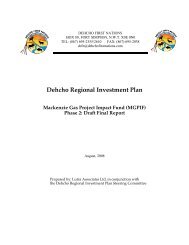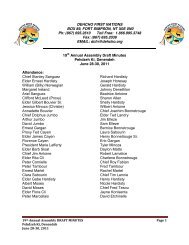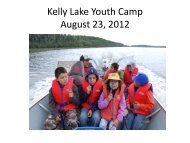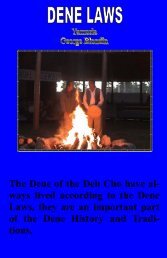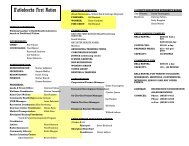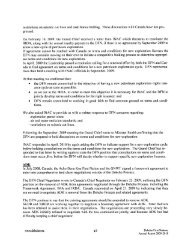NWT 2011-2015 - NWT Species at Risk
NWT 2011-2015 - NWT Species at Risk
NWT 2011-2015 - NWT Species at Risk
You also want an ePaper? Increase the reach of your titles
YUMPU automatically turns print PDFs into web optimized ePapers that Google loves.
4. D<strong>at</strong>a Sources and Methods – How did we rank species?<br />
Evalu<strong>at</strong>ion Process<br />
From Infobase to General St<strong>at</strong>us Ranks<br />
Guidelines were developed to convert d<strong>at</strong>a and inform<strong>at</strong>ion into seven indic<strong>at</strong>ors. These indic<strong>at</strong>ors were scored to produce a<br />
st<strong>at</strong>us rank for each species. The seven biological indic<strong>at</strong>ors used to evalu<strong>at</strong>e the biological st<strong>at</strong>us of a species are given below.<br />
SIZE<br />
1A Popul<strong>at</strong>ion Size = the current estim<strong>at</strong>e of the total<br />
number of m<strong>at</strong>ure individuals.<br />
1B Number of Occurrences = the estim<strong>at</strong>ed number<br />
of occurrences where the species currently persists. An<br />
occurrence is a loc<strong>at</strong>ion or place where a species is found,<br />
in which a single event may affect all individuals of the<br />
popul<strong>at</strong>ion.<br />
1C Distribution = the current range. In this report,<br />
distribution was calcul<strong>at</strong>ed as the percentage of total<br />
<strong>NWT</strong> land or marine area covered by the range of the<br />
species.<br />
TREND<br />
2A Trend in Popul<strong>at</strong>ion = an estim<strong>at</strong>e of the observed<br />
change in number of m<strong>at</strong>ure individuals over time.<br />
2B Trend in Distribution = an estim<strong>at</strong>e of the observed<br />
change in area of range over time.<br />
THREAT<br />
3A Thre<strong>at</strong>s to Popul<strong>at</strong>ion = observed, inferred,<br />
or projected factors affecting individuals or popul<strong>at</strong>ions<br />
th<strong>at</strong> may result in popul<strong>at</strong>ion declines over the next<br />
5 years.<br />
3B Thre<strong>at</strong>s to Habit<strong>at</strong> = observed, inferred, or projected<br />
habit<strong>at</strong> alter<strong>at</strong>ions th<strong>at</strong> may result in popul<strong>at</strong>ion declines<br />
over the next 5 years.<br />
Each indic<strong>at</strong>or was given a score according to the following<br />
m<strong>at</strong>rix. The scores were then converted into a general st<strong>at</strong>us<br />
by following guidelines shown in the scoring m<strong>at</strong>rix. As a<br />
guide, the species is assigned the highest general st<strong>at</strong>us<br />
(from May Be At <strong>Risk</strong>, Sensitive to Secure) reached using<br />
any indic<strong>at</strong>or.<br />
8<br />
<strong>NWT</strong> <strong>Species</strong> <strong>2011</strong>-<strong>2015</strong>



